Intel Core i7 3820 Review: $285 Quad-Core Sandy Bridge E
by Anand Lal Shimpi on December 29, 2011 2:28 AM EST- Posted in
- CPUs
- Intel
- Sandy Bridge
- Sandy Bridge E
Windows 7 Application Performance
3dsmax 9
Today's desktop processors are more than fast enough to do professional level 3D rendering at home. To look at performance under 3dsmax we ran the SPECapc 3dsmax 8 benchmark (only the CPU rendering tests) under 3dsmax 9 SP1. The results reported are the rendering composite scores.
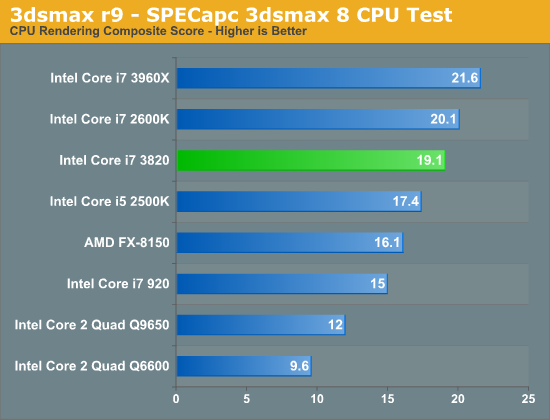
Cinebench 11.5
Created by the Cinema 4D folks we have Cinebench, a popular 3D rendering benchmark that gives us both single and multi-threaded 3D rendering results.
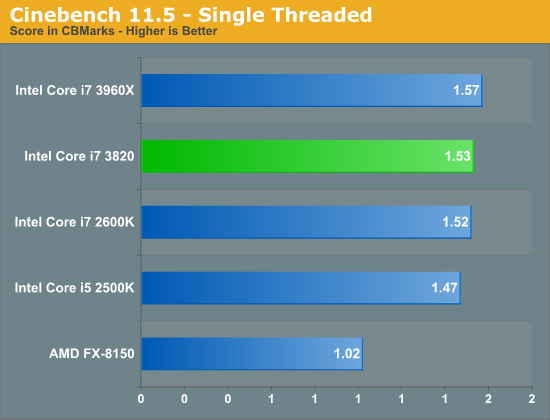
With only a 100MHz clock speed advantage over a 2600K when running in single core turbo mode, the 3820 isn't much faster than the 2600K in our single threaded Cinebench test. The additional L3 cache doesn't have much of an impact here, although I suspect that has more to do with this particular workload rather than a general statement about the 3820. Let's look at multithreaded perf:
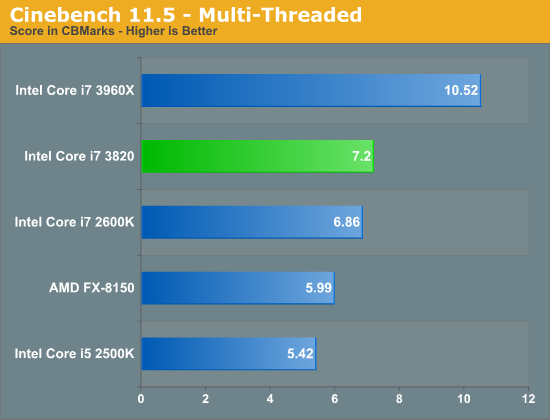
The performance gap increases to 5% once we ramp up thread count. The extra performance is mostly due to clock speed here, although you'll see later on that there are some applications that definitely appreciate the larger L3 cache.
7-Zip Benchmark
While Cinebench shows us multithreaded floating point performance, the 7-zip benchmark gives us an indication of multithreaded integer performance:
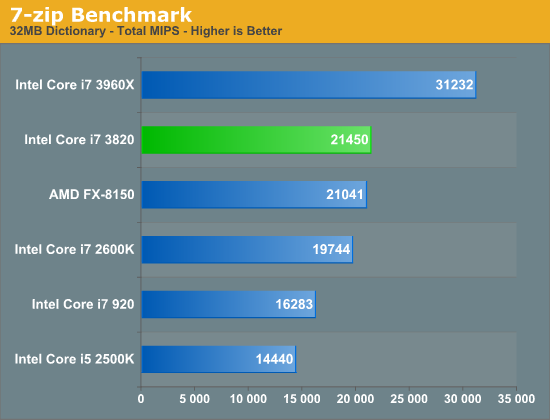
The 7-zip benchmark gives us a good example of what the SNB-E platform can offer given the right workload. Here we see an 8.6% performance advantage, despite a much smaller clock speed advantage. The added L3 cache helps out a bit here, although obviously there's a huge gap between the 3820 and its hexa-core brethren.
PAR2 Benchmark
Par2 is an application used for reconstructing downloaded archives. It can generate parity data from a given archive and later use it to recover the archive
Chuchusoft took the source code of par2cmdline 0.4 and parallelized it using Intel’s Threading Building Blocks 2.1. The result is a version of par2cmdline that can spawn multiple threads to repair par2 archives. For this test we took a 708MB archive, corrupted nearly 60MB of it, and used the multithreaded par2cmdline to recover it. The scores reported are the repair and recover time in seconds.

In tests that have more of an IO influence the difference between the 3820 and the 2600K is negligible, it will take higher clock speeds and more cores to really separate SNB-E from the vanilla SNB systems.
TrueCrypt Benchmark
TrueCrypt is a very popular encryption package that offers full AES-NI support. The application also features a built-in encryption benchmark that we can use to measure CPU performance:
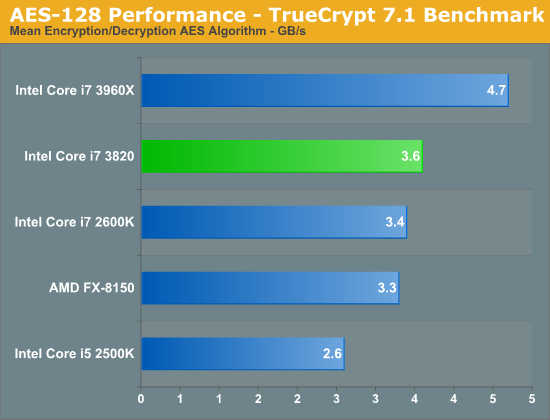
Encryption speed once again scales with core count and clock speeds, the additional L3 cache doesn't do much in this benchmark.
x264 HD 3.03 Benchmark
Graysky's x264 HD test uses x264 to encode a 4Mbps 720p MPEG-2 source. The focus here is on quality rather than speed, thus the benchmark uses a 2-pass encode and reports the average frame rate in each pass.
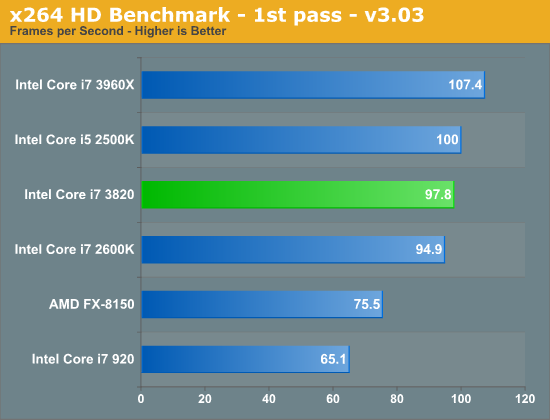
We see a slight advantage over the 2600K in our x264 HD benchmark, however video transcoding doesn't benefit all that much from the small gains the 3820 offers. Most client users would be better off with the Quick Sync enabled 2600K, and the serious video professionals will want to invest in a six-core 3930K at the minimum.
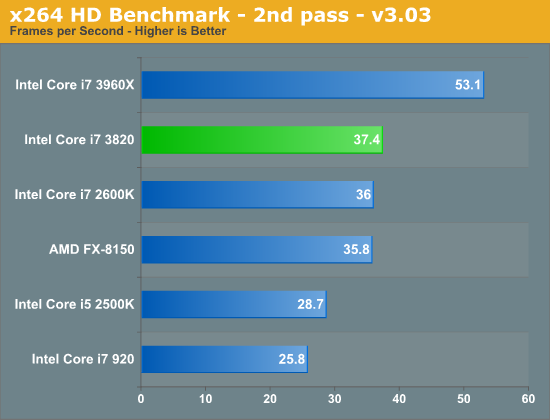
Compile Chromium Test
You guys asked for it and finally I have something I feel is a good software build test. Using Visual Studio 2008 I'm compiling Chromium. It's a pretty huge project that takes over forty minutes to compile from the command line on the Core i3 2100. But the results are repeatable and the compile process will stress all 12 threads at 100% for almost the entire time on a 980X so it works for me.
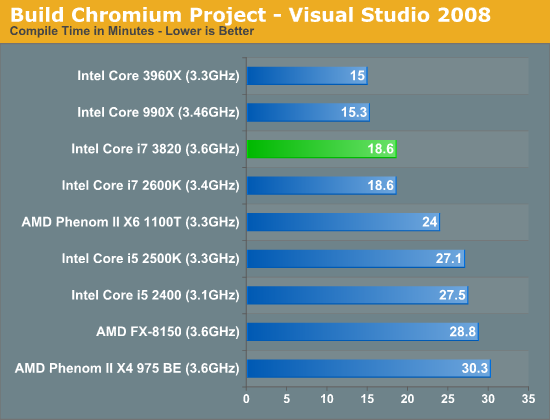
Again we see a step function improvement when moving from four to six cores in our compile test, but no change between the 2600K and 3820. If you're building a dev workstation you're going to either want to save money and grab a 2600K or move to six cores for better performance. It is worth mentioning however that if you need eight DIMM slots the 3820 might be a better option than the 2600K, allowing you to outfit your workstation with insane amounts of memory.
Excel Monte Carlo
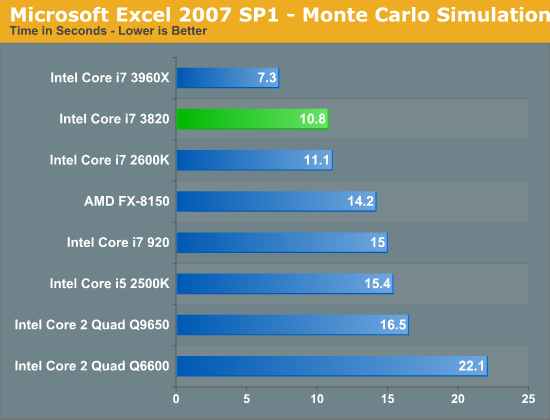
Our Monte Carlo simulation test is CPU bound but the 3820 shows a marginal improvement over the 2600K.
SYSMark 2007 & 2012
Although not the best indication of overall system performance, the SYSMark suites do give us a good idea of lighter workloads than we're used to testing. SYSMark 2007 is a better indication of low thread count performance, although 2012 isn't tremendously better in that regard.
In 2007 we see mild gains over the 2600K, although 2012 shows a much bigger gap between the 3820 and the 2500K due to the former's support for 8 threads vs. 4.
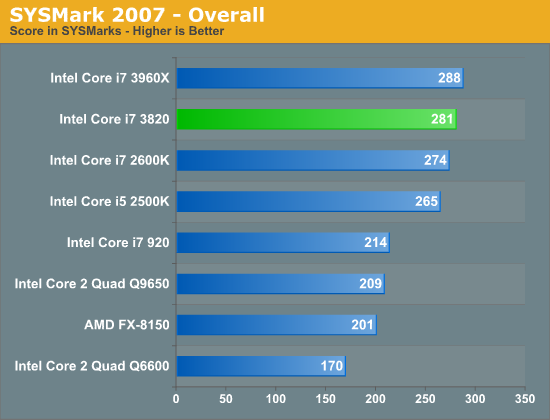
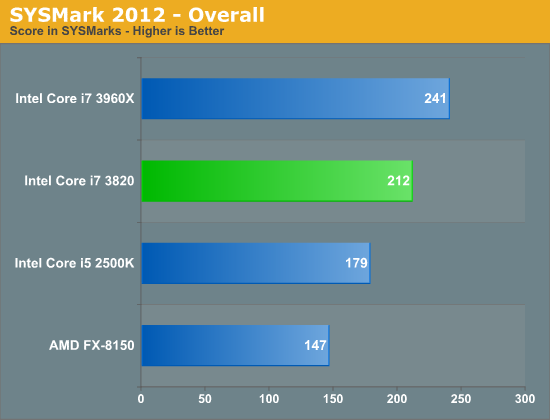










84 Comments
View All Comments
Hrel - Thursday, December 29, 2011 - link
So, shouldn't there be a price cut coming on 2700k, 2600k and other similar CPU's? If not Intel is being a dick again.SlyNine - Thursday, December 29, 2011 - link
Well no, There is no quick synk ( I believe) no IGP. it should be a cheaper chip.SlyNine - Thursday, December 29, 2011 - link
Without a IGP I guess there couldn't be quick synk. So forget the (I believe) partTetracycloide - Thursday, December 29, 2011 - link
So they're adding an IGP most users of the k series CPUs don't want, need, or use, charging them for it, and that means no, they're not a dick? I'm not following. I mean if this is really the reason to keep the current pricing on those SKUs then there's really no other option: Intel is being a dick again.Tetracycloide - Thursday, December 29, 2011 - link
Well, in fairness to Intel they're being a dick by offering this product at a pretty astonishingly low price for what's on offer which just makes their other SKUs look overpriced by comparison.SlyNine - Thursday, December 29, 2011 - link
How so, many people want Quick synk which REQUIRES the IGP. So explain how Intel is being a dick?Besides, Like there is a way for Intel to remove the IGP. Be practical or go home.
SaltwaterC - Wednesday, January 4, 2012 - link
Food for thought ... http://ark.intel.com/compare/52213,52276,52277,522...chizow - Thursday, December 29, 2011 - link
I haven't followed SB-E that closely but I figured the 4-core derivative would be a badly cut down (reject) version of the 8-core chip, basically the dregs of the wafer basically cut down to half usable.Can't believe they went with an entirely new die that still benefits from the greater 2.5MB L3 amount per core. It should actually perform better than the 3930K in cases that use 4 cores or less.....amazing. Intel couldn't have made this chip only to become a $280 desktop part....are they planning to use it for their low-end servers as well?
This also really provides that budget friendly high-end part for X79, basically the successor to the i7-920 for entry level enthusiasts. X79 still has its glaring omissions (USB 3.0, limited SATA6G, no Thunderbolt etc) but the 3820 makes it look better compared to SB and even IB.
$285 is an amazing price point.....I fully expect to see it for $199 at Micro Center a month from now. :) I wonder if there will be a K edition.....
Kevin G - Thursday, December 29, 2011 - link
I was figuring that the 4 core version was a cut down 8 core version too. I suspect that there will still be some of the 8 core dies being sold at 4 core just to get rid of inventory (OEM only parts perhaps?).I figure the reason for a native 4 core die is so that they can lower power consumption even further. Even with a completely disabled core, there is still some additional power consumption due to the internal ring bus. Speaking of which, I wonder if the reduction in hops in the internal ring bus will have any noticeable impact on performance anywhere (lower L3 cache latencies ect?).
The other reason for a native 4 core die is likely for high clock speed or ultra low power Xeon parts. There is a little known 4.4 Ghz dual core Xeon for socket 1366. It wouldn't surprise me if all the chips that test for high clock speeds are binned for a similar Xeon and not Core i7 3820's. :(
Though if we're lucky many of the X79 motherboards will work with the socket 2011 Xeon's.
Denithor - Thursday, December 29, 2011 - link
Low end servers would be my guess as well. All that memory bandwidth, PCIe lanes, perfect for applications where massive quantities of RAM (along with high speed access to it) is more important than raw cpu power.Seems like they ran an article on Facebook's server farms where FB uses AMD systems for RAM caching even though the cpu performance was much, much lower in the same power envelop simply because the AMD systems had more RAM sockets. This would seem like a direct replacement for those kind of systems.